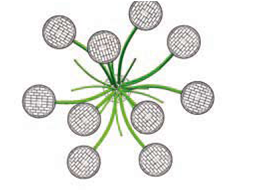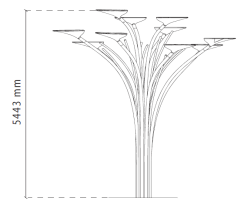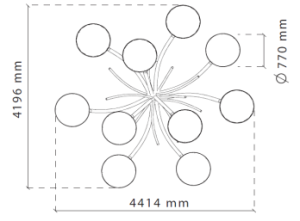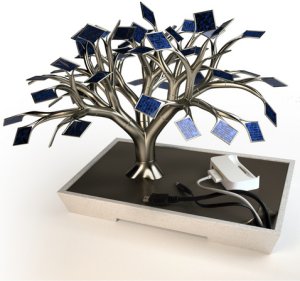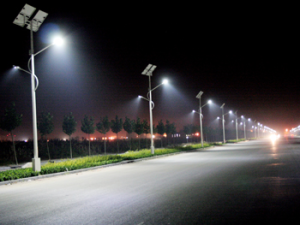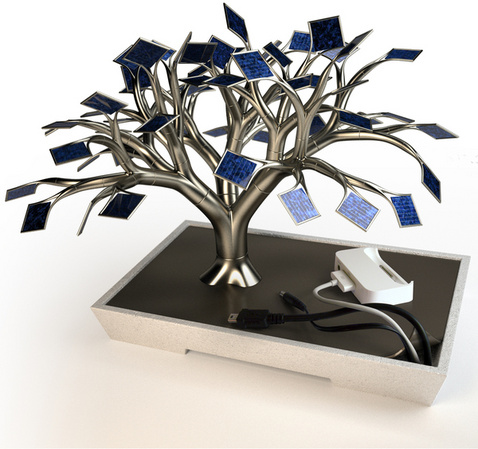
Title: SOLAR TREE – An artistic design to arrange Solar Panels
Authors: S.MadhuPriya & K.Divya, 1 Year BTech, EEE Department
College: Prakasam Engineering College, Kandukur
ABSTRACT: With oil supplies decreasing and prices increasing, the pros and cons of other energy sources are being debated world wide. Wind turbines produce high output, but people living near high-quality landscape don’t want their views spoiled. Biomass –plant products burnt as fuel is a proven technology. But some researchers estimate that powering all the world’s vehicles with biofuels means doubling the amount of land used for farming. Nuclear energy produces abundant power, but many fear the repercussions of catastrophes such as Chernobyl. The benefits of fusion energy, produced when two atoms are fused, could last for millennia. But it requires some of the most complex machinery on earth.
What is the future of alternative energy?
Solar tree sounds like the perfect solution for our future energy needs. The sun is constantly sending energy to the earth and all we need to do is to catch it and then use it. Unlike current energy sources , we are not going to run out of sunlight anytime soon ,it wouldn’t contribute to global warming, and it is available everywhere.
A solar tree is nothing but an artificial tree with photo-voltaic cells arranged in Fibonacci series manner in place of leaves. The amount of energy produced by this tree is more than that of normal flat array of solar cells.
I .INTRODUCTION: Solar tree is a revolutionary urban lighting concept that represents a perfect symbiosis between pioneering design and cutting-edge eco-compatible technology. Solar tree opens up new prospects for urban lighting in that it satisfies today’s most pressing environmental, social, Cultural and aesthetic demands.
The ability to continue innovative design with advanced technology, along with an acute sensitivity to environmental concerns makes an Artemide the ideal vehicle for the development of this project.
Solar tree draws inspiration from the organic forms of nature, reinterpreting the morphology of the tree and introducing the sensuality of the natural world into the urban context. This project clearly predicts that “it celebrates design, nature and art and represents the DNA of our time”. A sinuously elegant tree with ecologically intelligent ‘fruits’-that is LED bubbles that light up at night powered by sunlight accumulated during the day by solar panels .the aesthetic refinement of the design is thus integrated with an extremely high technological content.
II.RESEARCH AND EXPERIMENTATION:
Innovation and technology in the utilization and control of light; extreme attention to eco-compatible materials and to environmental needs in general; a deeply rooted vocation for fine design. These are the values that distinguish Artemide and the principles that underlie this new concept of public lighting.
Solar tree is the successful marriage of most advanced technology and the aesthetic requirements of the urban environments by the way o renewable energy. Artemide has dedicated its formidable skill and commitment to realizing these objectives, driven by a passion for research and sustainability and by an innate love of excellent design.
III.TECHNICAL INFORMATION:
- The structure consists in curved steel poles of different diameters, with an overall height of 5.5 meters.
- Each of the 10 “grass stalks” (ø 40 mm) has a 1W LED at its end protected by a lens in PMMA (polymethylmethacrylate).
- The 10 heads, which are capped by photovoltaic cells, are supported by poles 76 mm in diameter; 20 white LEDs of 1 W each are situated at the bottom part of 4 of these poles on an aluminum diffuser; a PMMA lens holds them in place.
- The base is made of reinforced concrete.
Led
Power of each head: . . . . . . . . . . . . . . . . . . . . . . . . . . . . 22W
Luminous flux of each head: . . . . . . . . . . . . . . . . . . . . 1250 lm
Colour temperature: . . . . . . . . . . . . . . . . . . . . . . . . . . 6000 K
Solar Panels
Tension: . . . . . . . . . . . . . . . . . . . . . . . . . . . . . . . . . . . . . . 12V
Peak power of each panel: . . . . . . . . . . . . . . . . . . . . . . . . 38W
Functioning: Solar Tree is designed to function both autonomously and in synchronization with the public grid. Electric grid), it uses the energy generated by the solar panels during the day to recharge the batteries. At dusk, which is recognized by automatically monitoring the solar panel output, the LED sources are activated and remain lit until dawn (or as long as the batteries remain charged). Solar Tree is capable of functioning for three consecutive days of cloudy or overcast weather.
When wired for coordinated functioning with the public lighting grid, it uses the energy generated by the solar panels to recharge the batteries and activate/deactivate the LED sources in synchrony with the grid, to which eventual surpluses of stored current can be relinquished.
Programs: Depending on specific needs, there are 3 operating programs that can be selected by infrared remote control:
- Prog0 (standard) ensures an average illumination of 8 lux by an internal regulator that maintains the LED sources at 25% of maximum power, from dusk to dawn (or exhaustion of current).
- Prog1 (event1) provides the LED sources with 100% of maximum power (33 lux) from dusk to dawn (or exhaustion of stored current); reverts automatically to Prog0 at dawn.
- Prog2 (event2) provides the LED sources with 100% of maximum power (33 lux) from dusk to dawn (or exhaustion of stored current), with the option of turning it on or off with the infrared remote; reverts automatically to Prog0 at dawn.
4 heads (80 LED) at 25% power: average illumination Em = 8 lux
4 heads (80 LED) at 100% power: average illumination Em = 33 lux
IV.ADVANCED SOLAR TREE:
“FIBANACCI SEQUENCE” TO MAKE SOLAR ENERGY BREAKETHROUGH
THEORY: Some photography, measurements, and investigating the work of other naturalists confirmed that plants produce new growth following a FIBANACCI SEQUENCE.
This pattern, where the previous numbers are added together to make the next number in sequence (1+1=2, 2+1=3,3+2=5,5+3=8 etc.,) and its corresponding golden ratio have been observed all over the nature world. In the same way “tree” using the sequence of leaves. Found on an oak tree by placing photovoltaic cells instead of leaves. The amount of energy collected by this tree is more than that of normal flat-panel model.
COMPARISION:
| TYPE OF SOLAR CELL ARRANGEMENT | ELECTRICITY |
| 1.flat panel model | 100% (say) |
| 2.solar tree with cells arranged( in Fibonacci series manner) | 20% more than flat panel model (i.e., nearly 120% more electricity.) |
Interesting results:
- The above model collected 2 ½ more hours of sunlight during the day. But the most interesting results were in December when the sun was at it’s lowest point in the sky.
- The tree design made 50% more electricity and the collection time of sunlight was up to 50% longer.
- The solar tree produces 2.31 watts in a parallel-series circuit, which becomes 8.28 kilowatt-hours. This totals 72532.8 kilowatt-hours, per year.
- In a series circuit, the solar tree system produces 2.68 watts, which becomes 9.648 kilowatt-hours, or 84516.48 kilowatt hours per year.
- But the single solar panel system produces precisely 1 watt, which becomes 3.6 kilowatt-hours, and 31536 kilowatt-hours per year.
- Solar tree in a series circuit produces 268% more power than the single solar panel system and 11% more power than the eight-panel system set up in the same manner.
- The solar tree in a parallel-series circuit is 142% more effective than the eight-panel system wired in series as well, and 263% more effective against a single solar panel system.
- 362664 kWhr/year per square meter of electricity can be produced, using only the scale model in a parallel-series circuit,
V.APPLICATIONS:
i.World’s best looking solar gadget charger
PRINCIPLE: photosynthesis solar tree concept.
Bonsai tree with 54 mini photovoltaic panels as leaves to soak up juice from the sun and charge your gadgets. Adapters get tucked away beneath a nice little tray, and your gadgets lay on top, basking in the shade.
Benefits:
- Solar tree gracefully plays both the role of decorative item and useful gadget.
- Paying homage to photosynthesis, the Photosynthesis tree proves to be a delightful plant that requires no watering and sustains.
ii. Solar trees in streets
Benefits:
- The day to day running and maintenance costs are slashed.
- There is a positive environmental impact as opposed to a negative one.
- The lack of wiring to be installed minimizes the disruption caused to, for example, road users during installation.
- Power outages have no impact whatsoever on street lighting in the area.
- Solar street lights can be easily erected in almost all locations.
CONCLUSION: Solar tree sounds like the perfect solution for our future energy needs. Solar tree is a revolutionary urban lighting concept that represents a perfect symbiosis between pioneering design and cutting-edge eco-compatible technology .The tree design made 50% more electricity and the collection time of sunlight was up to 50% longer. it helps the environment, saves money, cheap to use and you can have them on your homes .It’s free and last for lifetime and environment friendly.
References:
- Agrafiotis, C.; Roeb, M.; Konstandopoulos, A.G.; Nalbandian, L.; Zaspalis, V.T.; Sattler, C.; Stobbe, P.; Steele, A.M. (2005). “Solar water splitting for hydrogen production with monolithic reactors”.
- Anderson, Lorraine; Palkovic, Rick (1994). Cooking with Sunshine (The Complete Guide to Solar Cuisine with 150 Easy Sun-Cooked Recipes).
- Balcomb, J. Douglas (1992). Passive Solar Buildings. Massachusetts Institute of Technology. ..
- Bolton, James (1977). Solar Power and Fuels. Academic Press, Inc…
- Bradford, Travis (2006). Solar Revolution: The Economic Transformation of the Global Energy Industry..
- Butti, Ken; Perlin, John (1981). A Golden Thread (2500 Years of Solar Architecture and Technology).
- Carr, Donald E. (1976). Energy & the Earth Machine. W. W. Norton & Company..
- Daniels, Farrington (1964). Direct Use of the Sun’s Energy. Ballantine Books. .
- http://en.wikipedia.org/wiki/Solar_tree

